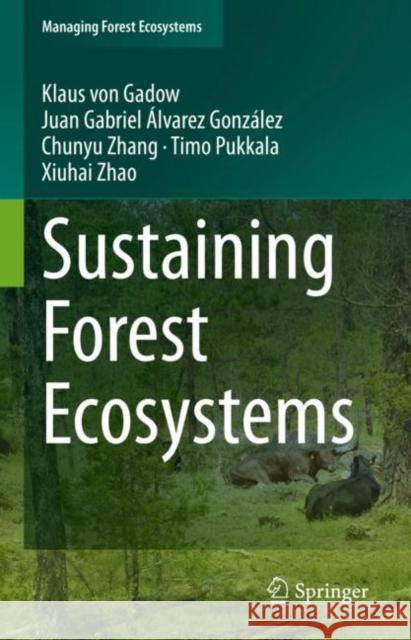Sustaining Forest Ecosystems » książka



Sustaining Forest Ecosystems
ISBN-13: 9783030587130 / Angielski / Twarda / 2021 / 419 str.
Sustaining Forest Ecosystems
ISBN-13: 9783030587130 / Angielski / Twarda / 2021 / 419 str.
(netto: 422,69 VAT: 5%)
Najniższa cena z 30 dni: 424,07
ok. 22 dni roboczych
Bez gwarancji dostawy przed świętami
Darmowa dostawa!
What is a Forest?.- Classification of Plant Communities.- Global Classifications.- Regional Classifications.- Potential Natural Vegetation.- Novel Forests.- Popular Myths.- The Myth of the “Climax Community”.- The Myth of the “Primeval Forest”.- Forest Anthromes: Domesticated Ecosystems.- To Act or not to Act?.- Forest Assessment and Observation.- Forest Assessment.- Some Selected Issues.- The Nested Plot Design.- Simulating a Test Area with Mapped Trees.- Seedlings, Saplings and Shrubs.- the Regeneration Circular Plot.- The Regeneration Neighborhood.- Generating a Sampling Schemen on a regular Grid.- An Example from Mongolia.- Remote Assessments.- Use of Airbornse Laser Scanning in Forest Inventory.- Numerical Delineation of Forest Stands.- Landsat.- Terrestrial Laser Scanning.- Estimating NPP based on MODIS.- Cost – Benefit Issues.- Field Experiments.- Spacing Experiments for Planted Ecosystems.- Short-Rotation Coppice Experiments.- Ecosystem Functioning and Biodiversity Experiments.- Longitudinal, Cross-Sectional and Interval Studies.- Continuous Forest Observation.- Early Observational Infrastructures.- New Forest Observational Studies.- China.- South Africa.- India.- Mexico.- Global Forest Observation.- Machine Learning.- Establishing an Observational Field Plot.- Assessment Protocols.- Presentation Standards.- Species Codes and Colors.- Plot Maps.- Plot Summaries.- Analysing Forest Ecosystems.- Forest Density.- Measuring Forest Density.- Basal Area.- Leaf Area Index.- Stand Density Index.- Nilson’s Sparsity.- Relative Spacing.- Crown Competition Factor.- Patterns of Density.- Planted Forests.- Natural Forests.- Forest Heterogeneity and Structure.- Species Diversity.- The Species-Area Relationships.- Non-Spatial Structure.- Unimodal Diameter Distributions.- Bimodal Diameter Distributions.- Specific Diameter-Height Relations.- Generalised Diameter-Height Relations.- Spatially Explicit Diameter-Height Relations.- Bivariate Diameter-Height Distributions.- Spatial Structure.- The Uniform Angle Index.- The Forest Ecosystem – A Mosaic of Neighborhoods.- Species Segregation and Mingling.- A System of Nearest Neighbor Statistics.- Implementing the Neighborhood System in R.- Extensions of the Mingling Concept.- Assessing Community Dissimilarity.- An Example using Taxonomic Distances.- Analysing Harvest Events.- Linguistic Variables.- Simple Numerical Variables.- Removal Preferences in a Spatial Context.- Simulating a Harvest Event.- The Gini Coefficient.- Reconstruction and Simulation.- Applications in Spatstat.- Developing your own R Code.- Simulating a Planted Forest.- The Shape and Growth of Forest Trees.- The Shape of Forest Trees.- The Tree Crown.- Crown Models of Higher Resolution.- The Crown Window.- The Stem.- Stem Profile Functions.- The Brink Function.- Modeling Stem Quality.- The Root System.- Compatible Biomass Models.- Developing a System of Compatible Biomass Equations.- Individual Tree Growth Models.- Modeling Tree Survival.- Competition Effects and Response to Competition.- Overtopping Basal Area: BAL and BALMOD.- Local Crowding.- Area Potentially Available.- Overlapping Zones of Influence.- the KKL Index.- Distance-Weighted Size-Ratio (Hegyi).- Other Competition Indices.- Examples of Individual Tree Growth Models.- Selecting Trees for Harvest.- The Four-Forester Problem.- Spatial Thinning Models.- Forest Production.- Site Models.- Site Index Systems based on Dominant Height.- A Site Index System based on the Guide-Curve Method.- A Site Index Systems based on the Algebraic Difference Equation Method.- Phytocentric and Geocentric Measures of Site Productivity.- Plant Communities.- Indicator Plant Species.- Climate Indices.- Soil Parameters.- Comparison of Methods.- Estimating Forest Production.- Estimating Element Content in Forest Production Models.- Production in Planted Forests.- Production in Continuous Cover Forests.- Forest Density and Production.- Examples of Forest Production Models.- A Fagus sylvatica Ecosystem.- A Eucalyptus grandis Ecosystem.- Estimating Production: No Observations.- Compatible Models of Growth and Production.- Transition Function for Tree Number Reduction.- Disaggregation involving Tree Diameters.- Disaggregation involving Height Estimation.- Output Functions.- Total and Merchantable Volume Estimation.- Biomass Distribution and Carbon Estimates.- Forest Production and Individual Tree Growth.- Modeling Harvest Events.- Separation Parameters.- Thinning Rules.- Designing Forest Ecosystems.- Risks and Preferences.- Estimating Abiotic Risks.- Estimating Biotic Risks.- Establishing a Preference Order.- Constrained Optimization.- A Pulpmill with Boiler Constraint.- Afforestation and Water Yield.- Sustaining Planted Forests.- Classical Methods.- Age Class Simulation.- Multi-Period Harvest Scheduling.- Sustaining Continuous Cover Forests.- the Inverse J-shaped Liocourt Curve.- Optimum Residual Structures.- Sustaining Green Landscapes.- Cradle-to-Grave Design.- Multiple Path Design.- Heuristic Combinatorial Optimization.- Simulated Annealing.- Tabu Search.- Genetic Algorithm.- Ant Colony Optimization.- Decentralized Heuristics.- Using Stand Level Optimization in Forest Level Planning.- Spatial Heuristic Optimization.- Use of Small Spatial Units in Forest Planning.- Tree Level Planning.- Application Examples.- Indira Gandhi Canal Forests.- A Forest in Germany.- A Planted Eucalyptus Ecosystem.- A Coastal Dune Ecosystem.- A Mountain Ecosystem.- A “Novel Ecosystem”.- A Forest Farm.- Literature.- Index.
Klaus v. Gadow has been teaching forest management at the Universities of Stellenbosch in South Africa and Göttingen in Germany. After his retirement in 2006, Beijing has become his third academic home where his research focus included aspects of quantitative ecology.
Chunyu Zhang (张春雨) is a professor of forest management at the Beijing Forestry University. The focus of his research is numerical ecology with particular emphasis on biodiversity, ecosystem productivity and forest modelling.
Juan Gabriel Álvarez González is professor of forest biometrics at the University of Santiago de Compostela in Spain. Among his path breaking achievements are compatible biomass systems and simultaneous modeling of tree growth and forest production.
Timo Pukkala is professor in the Department of Forest Sciences at the University of Eastern Finland. He has extensive experience in forest modeling with particular emphasis on ecosystem design. Timo developed the well-known MONSU system of forest planning.
Xiuhai Zhao (赵秀海) is a professor of forest ecology who established a unique network of very large stem-mapped forest plots covering the major forest ecosystems in China. He is a recognized scientific leader who attracts a great number of talented students to his large research team.
Humans are able to identify the causes and disastrous consequences of neglect and exploitation of the forest ecosystems of the earth. Sustaining the world's ecosystems, for our own benefit and for the survival of life on earth, requires a scientific approach based on evidence about forest diversity, structure and dynamics, and appropriate methods of ecological management.
1997-2025 DolnySlask.com Agencja Internetowa
KrainaKsiazek.PL - Księgarnia Internetowa









